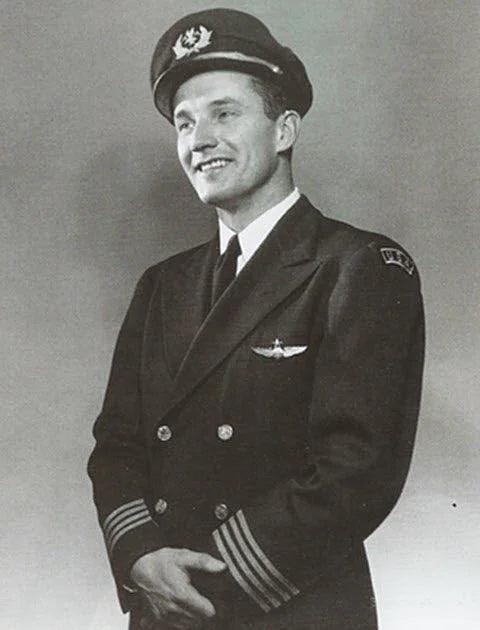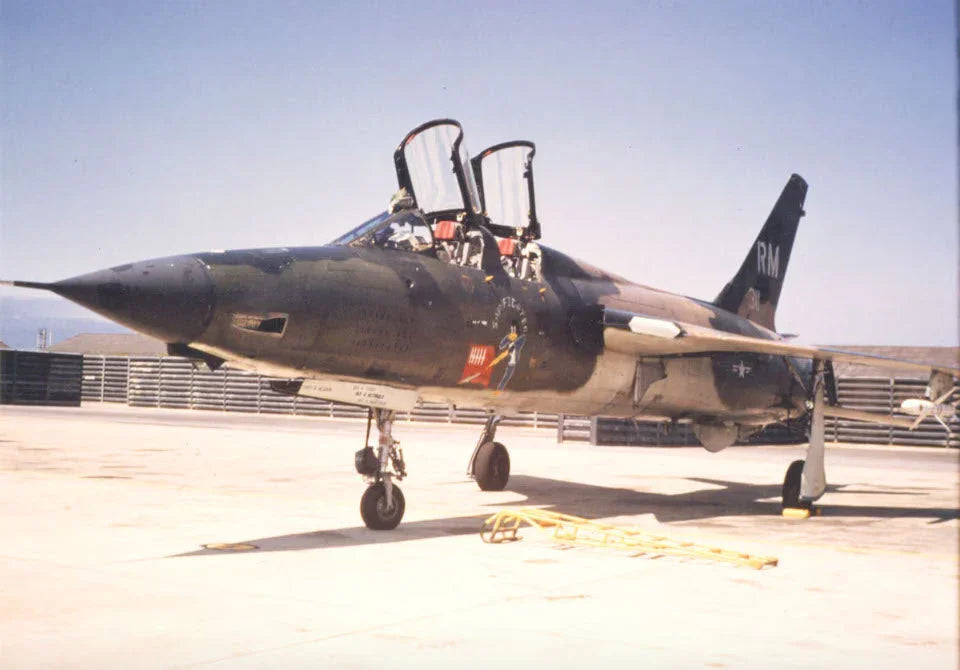Courage Above The Skies Of North Vietnam

An F-105 Wild Weasel III in flight.
Over North Vietnam, March 10, 1967
Here is the story of Captain Dethlefsen, recepient of the Air Force Medal of Honor:
"On March 10, 1967, as a flight of F-105 Thunderchiefs took off from Takhli Royal Thai Air Force Base Captain Merlyn Hans Dethlefsen eased the number three Thud into position as the four-ship formation headed north. This was his 78th combat mission. Over 500 miles away, in the North Vietnamese heartland, lay the Thai Nguyen steel mill and industrial complex. Nestled in a valley 40 miles north of Hanoi, and 70 miles from the Red Chinese border, the heavily defended complex was a vital cog in Ho Chi Minh's war machine. It had only recently been approved as a target for US fighter bombers.
Four Thunderchief Wild Weasel IIIs, with the call sign "Lincoln," were scheduled to be the first flight on target that day. Their mission was to knock out the lethal defenses that ringed the target: surface to air missiles (SAMs), antiaircraft artillery (AAA), and automatic weapons. There was also a good possibility that the Thuds would be greeted by Soviet- and Chinese-built MIG interceptors.
The flight leader and Captain Dethlefsen each piloted two-seat Thunderchiefs for the wild weasel mission. As they neared hostile territory the back seater, or "bear," would be busy scanning his gear for the telltale signals that could pinpoint North Vietnamese defenses. On schedule, the F-105 pilots rendezvoused with a tanker and refueled. They departed the tanker just five minutes ahead of the main strike force and prepared to cross the enemy border, hoping the good weather would hold.

A map of Indochina showing Vietnam and where Capt. Dethlefsen won the Medal of Honor
Fighter pilots who had survived many missions over the north had developed a sound combat tactic. They would strike the target quickly, delivering their ordnance on one pass, then pull off, using maximum power and violent evasive maneuvers, to head for home. Merl Dethlefsen had used this formula many times and had never been hit by flak. Those who attempted a second pass on the target often did not live to tell about it.
Lincoln had guided his formation at medium altitude to the north of Thai Nguyen. About two miles from the target, they zoomed for altitude and rolled into a steep diving attack on the active SAM site.
Merl and his wingman were nearly a mile behind the first element when they lost sight of the leader in the most intense flak imaginable. The number two ship broke hard to the right and Merl followed. A moment later, the parachute beeper signal on the emergency radio channel confirmed that the lead crew had ejected from their crippled aircraft.
Number two, trying desperately to escape from the hornet's nest around Thai Nguyen, reported that his Thud had been badly damaged. Merl Dethlefsen took command of the flight. He remembers, "We were still ahead of the strike force, and they (the strike force) were still vulnerable. We had fuel and missiles, guns and bombs, and the job wasn't done yet. Lincoln lead had seen the target and launched a missile, but it had missed. I decided we would stay. Coming around, I studied the flak pattern. It wasn't a matter of being able to avoid the flak, but of finding the least-intense areas."
Captain Dethlefsen's wingman, Major Kenneth Bell recalls, "We sometimes had targets where we got no flak at all. Apparently, the enemy didn't care about them. But this one was different. When we got that kind of greeting at Thai Nguyen you know we were hitting something they wanted to hang on to. It was a vital target, and its loss would hurt them."
Merl and his back seater, Captain Kevin "Mike" Gilroy, had located the approximate position of the SAM site on the first pass. As he maneuvered the aircraft to line up with the target, Merl spotted two MIG-2ls closing fast from the rear quadrant. He fired his radar-seeking missile at the SAM site and veered sharply away as one of the MIGs triggered a missile toward the Thud.
Dethlefsen described how he shook off the attackers, "I broke to the right, down through the flak. I figured that would give me the best chance of evading both the heat-seeking missile and the Migs’s guns. Didn't think the MIGs would want to follow me through that stuff. They didn't."
It was standard procedure for F-105 pilots under attack by MIGs to jettison their ordnance, engage the afterburner, and head for the treetops, where the Thud could outrace the interceptors. The heavy fighter bomber was no match for the maneuverable MIG in a dogfight. As Merl repositioned for another pass, he saw two more MIG-2ls and evaded them with a tight left break. He elected to retain his ordinance, but now he had another problem.
The antiaircraft artillery had taken its toll. At least one of the 57-millimeter gunners had scored a bullseye, jolting the Thud with a direct hit. Miraculously, the flight controls and engine responded normally as Captain Dethlefsen checked his aircraft out. Chunks of shrapnel through the bottom of the Thud's fuselage and the left wingtip had not damaged any of her vital systems. The two-man crew again turned their attention to the SAM site, and Merl remembers that the main force was already leaving the industrial complex.
"I could hear the strike force withdrawing. I had permission to stay there after they left. That steel mill with the related industry was a big target - too big to knock out with one strike. I knew those fighter-bombers would be back tomorrow. Same route, right over this area. My aircraft was working well enough to be effective. With the weather the way it was that day I knew we would never have a better chance.
So, I made up my mind to stay until I got that SAM site or they got me."
Maneuvering around the flak pattern, Merl spotted another SAM site dead ahead. He squeezed off a missile and the SAM radar shut down.
Smoke and dust from the main strike on the complex began to drift over the defensive positions as the pilot and his rear seater strained to spot the original SAM site. Merl eased the streaking Thunderchief down on the deck for a better look.
Throughout the harrowing sequence of events, Ken Bell had stuck to his leader like glue. His 105 had been hit by both AAA and a MIG. Because of a damaged aileron, Ken could turn his Thud only to the right as he followed Merlyn Dethlefsen down the chute once more. At last, the weasel delivered the knockout punch. Merl dropped his bombs squarely on the site and followed with a cannon pass, his 20-millimeter gun blazing away. The SAM site burned as the 105s pulled off.
The two battle-weary Thuds sped toward the tanker and home station. Pilots who would fly over Thai Nguyen on another day were glad that Captain Dethlefsen had stayed.
"All I did was the job I was sent to do," Dethlefsen said. "It had been quite a while since we had been able to go into the Hanoi area. So, while the weather held we were able to do some pretty good work. It was a case of doing my job to the best of my ability. I think that is what we mean when we call ourselves professional airmen in the Air Force."
Merl Dethlefsen's understatement of his heroic contribution reflects the attitude of the pilots who risked their lives daily over the north. Each considered himself a part of the team. The destruction of vital targets in the enemy's stronghold would never be a one-man operation."
Capt. Dethlefsen Medal of Honor Citation
"Maj. Dethlefsen was one of a flight of F-105 aircraft engaged in a fire suppression mission designed to destroy a key antiaircraft defensive complex containing surface-to-air missiles (SAM), an exceptionally heavy concentration of antiaircraft artillery, and other automatic weapons. The defensive network was situated to dominate the approach and provide protection to an important North Vietnam industrial center that was scheduled to be attacked by fighter bombers immediately after the strike by Maj. Dethlefsen's flight. In the initial attack on the defensive complex the lead aircraft was crippled, and Maj. Dethlefsen's aircraft was extensively damaged by the intense enemy fire. Realizing that the success of the impending fighter bomber attack on the center now depended on his ability to effectively suppress the defensive fire, Maj. Dethlefsen ignored the enemy's overwhelming firepower and the damage to his aircraft and pressed his attack. Despite a continuing hail of antiaircraft fire, deadly surface-to-air missiles, and counterattacks by MIG interceptors, Maj. Dethlefsen flew repeated close-range strikes to silence the enemy defensive positions with bombs and cannon fire. His action in rendering ineffective the defensive SAM and antiaircraft artillery sites enabled the ensuing fighter bombers to strike successfully the important industrial target without loss or damage to their aircraft, thereby appreciably reducing the enemy's ability to provide essential war material. Maj. Dethlefsen's consummate skill and selfless dedication to this significant mission were in keeping with the highest traditions of the U.S. Air Force and reflect great credit upon himself and the Armed Forces of his country."
I hope you enjoyed this trip through some of the history of aviation. If you enjoyed this trip, and are new to this newsletter, sign up to receive your own weekly newsletter here: Subscribe here!
Until next time, keep your eyes safe and focused on what's ahead of you, Hersch!







Leave a comment
This site is protected by hCaptcha and the hCaptcha Privacy Policy and Terms of Service apply.